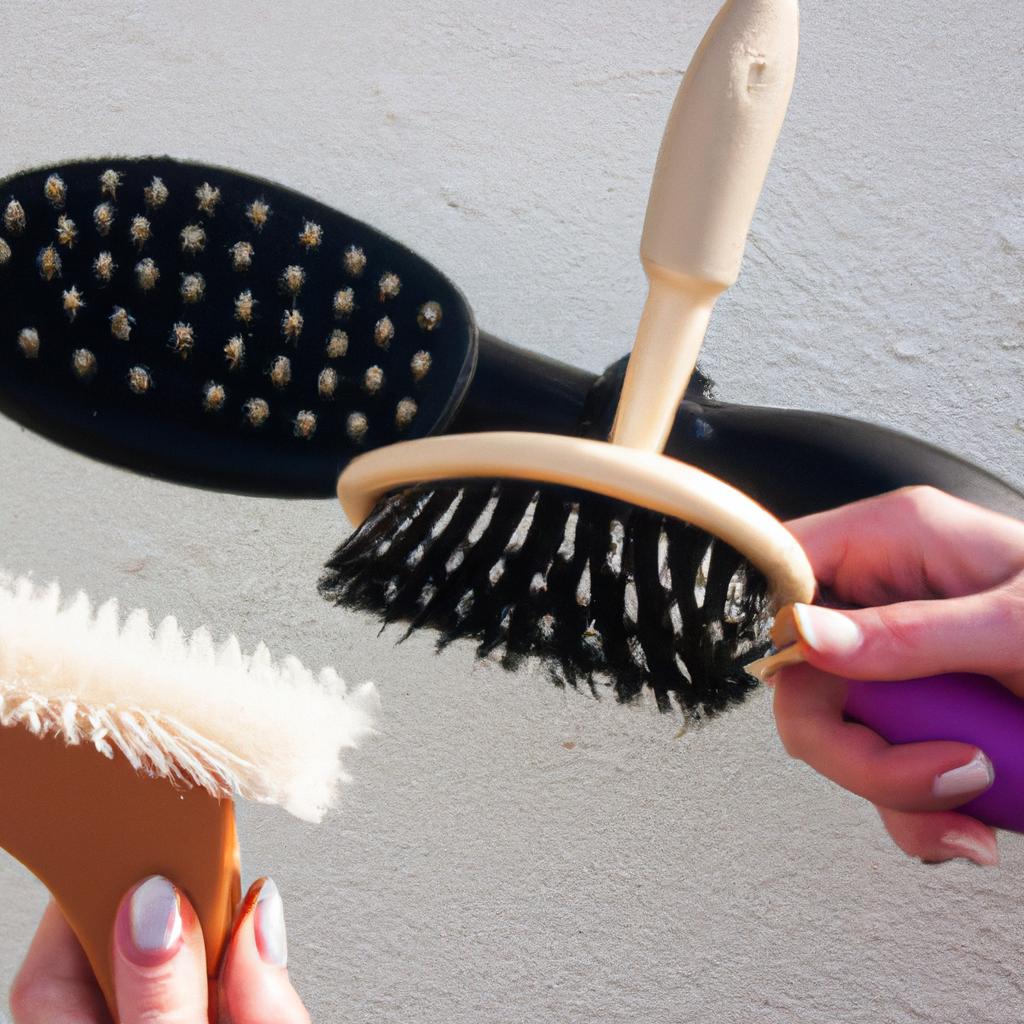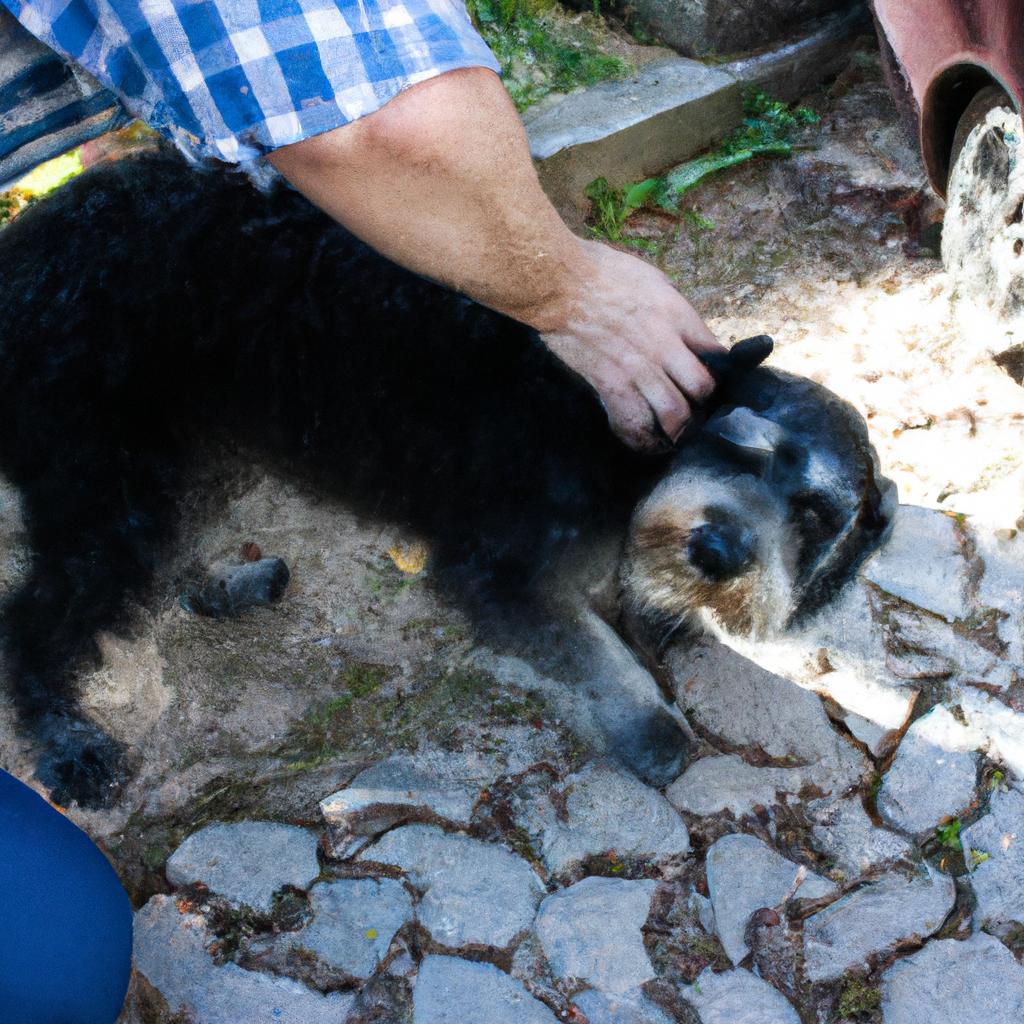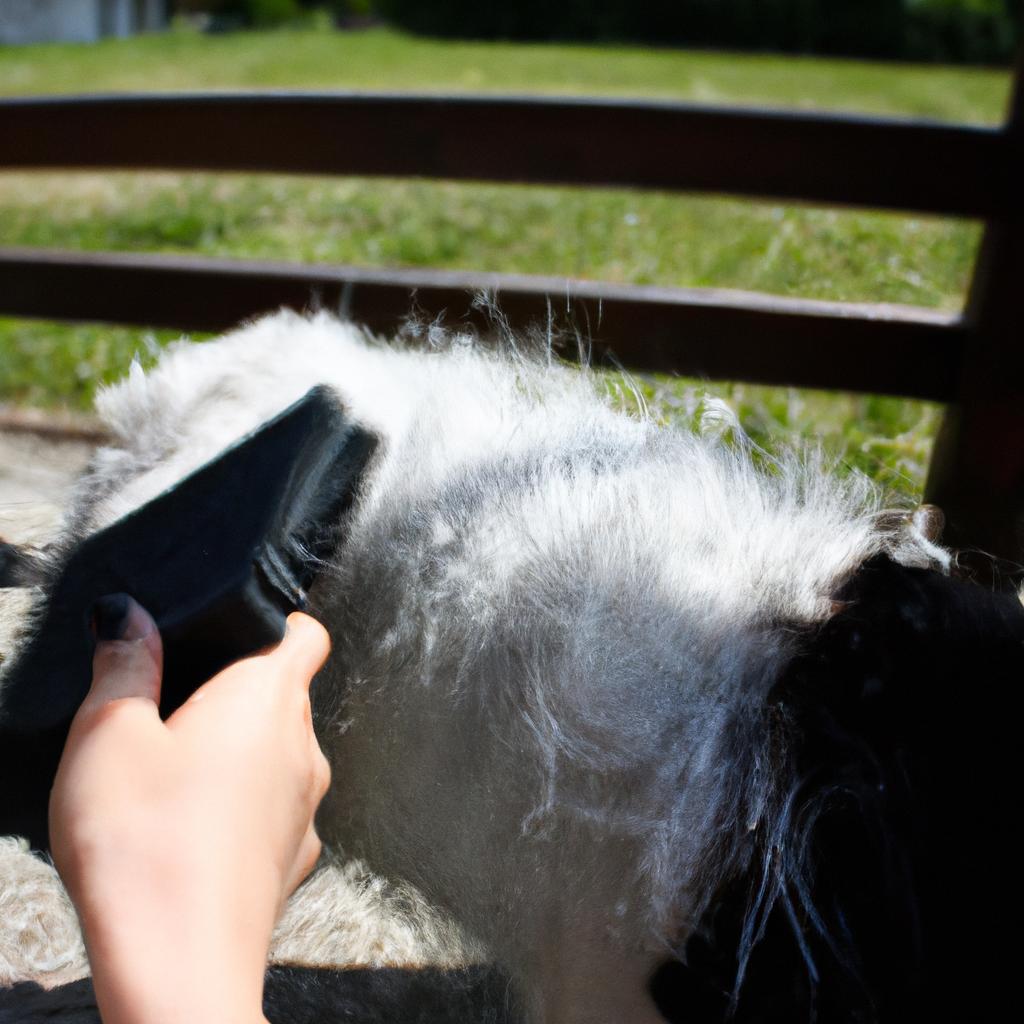Scissor Grooming: Essential Techniques for Dog Grooming Salon: Coat Brushing

Dog grooming salons play a vital role in maintaining the overall health and appearance of our beloved canine companions. Among the various techniques used in these salons, scissor grooming holds significant importance for achieving well-groomed coats. This article aims to explore the essential techniques involved in scissor grooming, with a specific focus on coat brushing. By employing proper scissor grooming techniques, dog groomers can effectively remove tangles, matting, and debris from the dog’s fur, resulting in a clean and healthy coat.
Consider the case of Max, a golden retriever who regularly visits his local dog grooming salon. Despite having a beautiful coat, Max often faces challenges due to his long hair that tends to tangle easily. In such cases, regular brushing plays a crucial role in preventing matting and keeping his fur smooth and lustrous. The use of scissors during this process helps groomers precisely trim any excess or uneven hair length while ensuring that Max remains comfortable throughout the session. Understanding the fundamental aspects of scissor grooming is imperative for every professional dog groomer as it allows them to provide quality care tailored to each individual pet’s needs.
Scissor grooming encompasses various techniques aimed at maintaining dogs’ coats aesthetically pleasing while promoting their overall well-being . These techniques include coat thinning, feathering, blending, and shaping. Coat thinning involves using thinning shears to remove excess hair and create a more balanced look. Feathering is the process of delicately trimming the ends of the dog’s fur to achieve a soft and natural appearance. Blending involves seamlessly combining different lengths of hair to create smooth transitions between areas. Shaping focuses on creating specific styles or patterns such as teddy bear cuts or breed-specific trims.
To effectively perform scissor grooming, it is crucial for groomers to have an understanding of canine anatomy and coat types. Different breeds have unique coat textures, lengths, and growth patterns that require specific grooming techniques. For example, curly-haired breeds like poodles may need more frequent scissor grooming sessions to maintain their signature looks.
In addition to brushing and scissor work, proper maintenance of grooming tools is essential to ensure optimal results. Regular cleaning and sharpening of scissors are important for maintaining their functionality and preventing any discomfort or harm caused by dull blades.
Overall, scissor grooming is an indispensable aspect of dog care that helps maintain both the aesthetic appeal and health of our furry friends’ coats. By employing the right techniques and staying up-to-date with industry advancements, professional dog groomers can provide top-notch services tailored to each dog’s individual needs.
Choosing the Right Scissors
Imagine this scenario: you are a professional dog groomer, meticulously brushing through a tangled and matted coat. As you struggle to untangle each knot, you realize that your scissors aren’t cutting it—literally. The blades are dull, making it difficult to achieve precise cuts without causing discomfort to the dog. This is why choosing the right scissors for grooming is crucial.
To begin with, there are various factors to consider when selecting scissors for dog grooming. One important aspect is the type of coat being worked on. Different breeds have different types of coats, such as curly, wiry, or dense fur. For instance, a Poodle’s curly locks require thinning shears to create even layers and prevent matting. On the other hand, smooth-coated breeds like Boxers may only need straight-blade scissors for trimming purposes.
In addition to considering the coat type, another factor to take into account is the size and weight of the scissors. Grooming can be physically demanding work; using heavy or unwieldy scissors increases fatigue and decreases precision. It is recommended to choose lightweight scissors with ergonomic handles that offer comfort during long hours of use.
Furthermore, quality should never be compromised when investing in grooming tools. High-quality stainless steel blades not only ensure durability but also provide sharpness for clean cuts. Remember that blunt blades can lead to painful pulling or tugging on a dog’s hair, causing distress during grooming sessions.
To summarize:
- Consider the type of coat being groomed.
- Choose scissors based on their size and weight.
- Prioritize high-quality stainless steel blades.
- Opt for ergonomic handles for added comfort.
By paying attention to these essential points before purchasing grooming scissors, professionals can improve their efficiency while ensuring optimal care for dogs’ coats.
Moving forward with our discussion on effective scissor grooming techniques, let us now delve into prepping the dog’s coat.
Prepping the Dog’s Coat
In the previous section, we discussed the importance of selecting the right scissors for dog grooming. Now, let’s move on to the next crucial step in achieving a well-groomed canine companion – prepping the dog’s coat. To illustrate this process, let’s consider an example where a Golden Retriever named Bella visits a dog grooming salon with her owner.
To ensure successful scissor grooming, it is essential to properly prepare the dog’s coat beforehand. Here are some key steps to follow:
-
Brushing: Start by carefully brushing out any tangles or mats in Bella’s fur using a slicker brush or comb. This helps remove loose hair and prevents further matting during the grooming process.
-
Bathing: Next, give Bella a thorough bath using a gentle shampoo suitable for her coat type. Make sure to rinse off all traces of soap to avoid skin irritation.
-
Drying: After bathing, towel-dry Bella as much as possible before using a blow dryer on low heat setting to finish drying her completely. It is important not to use high heat settings close to the dog’s skin, as it can cause discomfort and potentially burn them.
-
Trimming Nails: While preparing Bella’s coat, don’t forget about her nails! Trim them carefully using specialized pet nail clippers or grinders designed specifically for dogs. Be cautious not to cut too close to the quick (the sensitive area inside each nail), which may cause bleeding and pain.
By following these steps diligently, groomers can create a clean canvas ready for scissor grooming techniques that will enhance both aesthetics and comfort for furry friends like Bella.
| Key Prepping Steps | Benefits |
|---|---|
| Brushing | Removes tangles and mats |
| Bathing | Cleanses the coat and removes dirt |
| Drying | Ensures a dry foundation for grooming, preventing discomfort or skin issues |
| Trimming Nails | Promotes overall paw health by preventing overgrowth, potential nail splitting, and discomfort from nails touching hard surfaces |
In this section, we have discussed the importance of properly prepping a dog’s coat before scissor grooming. Now that Bella’s fur is ready to be styled, let’s move on to mastering the proper scissor holding technique in the next section.
Proper Scissor Holding Technique
Building on the foundation of prepping the dog’s coat, it is crucial for groomers to develop proper scissor holding technique. By mastering this essential skill, groomers can achieve precise and safe cuts that enhance the overall appearance of the dog. Let us explore some key aspects of scissor holding technique.
Example: Consider a scenario where a groomer is tasked with grooming a long-haired Poodle for an upcoming dog show. The groomer needs to create a balanced and elegant look by carefully trimming the dog’s coat. In order to accomplish this, they must first ensure they have a solid grasp on their scissors.
To effectively hold the scissors during grooming sessions, groomers should keep in mind the following:
- Grip strength: Maintaining a firm yet comfortable grip on the scissors allows for better control while cutting through different types of hair textures.
- Finger positioning: Placing fingers correctly through designated holes or rings ensures stability and precision when maneuvering the scissors.
- Hand movement coordination: Coordinating hand movements with scissor actions helps maintain consistency throughout each cut.
- Wrist alignment: Keeping wrists straight reduces strain and fatigue, allowing for more accurate cuts without compromising comfort.
| Key Aspects of Scissor Holding Technique |
|---|
| – Grip strength |
| – Finger positioning |
| – Hand movement coordination |
| – Wrist alignment |
By focusing on these aspects, groomers can refine their scissor holding skills, resulting in professional-looking trims that meet client expectations. With practice and attention to detail, groomers will gain confidence in handling various breeds’ coats efficiently.
Transition into “Trimming Around the Ears and Eyes”: Now that we have established proper scissor holding technique as a fundamental aspect of grooming, let us move forward to exploring another crucial area – trimming around the ears and eyes.
Trimming Around the Ears and Eyes
Building on the proper scissor holding technique, mastering trimming around sensitive areas such as the ears and eyes is crucial in achieving a polished groom. Let’s delve into the techniques that ensure precision and safety when working near these delicate regions.
Trimming around the ears and eyes requires utmost care to avoid any accidental injuries or discomfort for the dog. For instance, consider a case where you are grooming a small breed with long hair around their ears. To maintain cleanliness and prevent matting, gently comb through the fur surrounding the ear canal before attempting any cuts. This ensures that no tangles or knots interfere with your scissors’ movements.
To effectively trim around the eyes without causing stress or harm to the dog, follow these essential steps:
- Begin by softly brushing away any loose hairs from above and below each eye.
- Use rounded tip scissor blades to carefully remove stray hairs obstructing vision without coming too close to the eyelid.
- Take frequent breaks during this process to allow the dog time to relax and adjust.
- Reward them with treats and praise throughout to positively reinforce calm behavior.
Let us explore how trimming around sensitive areas can benefit both dogs and owners:
- Enhanced visibility leads to improved overall well-being of dogs.
- Reduced chances of eye irritation caused by overgrown facial hair.
- Increased bonding between dogs and owners due to regular grooming routines.
- Boosted confidence levels in dogs who feel comfortable showing off their clean-cut appearance.
Emotional Table:
Below is an overview of common challenges faced when trimming around sensitive areas along with corresponding solutions:
| Challenge | Solution |
|---|---|
| Nervousness | Provide a calming environment |
| Difficulty reaching spots | Utilize specialized tools like curved shears |
| Irritated skin | Apply soothing products after trimming |
| Uneven cutting | Regular practice using proper techniques |
Incorporating these techniques and keeping in mind the emotional benefits for dogs and their owners, you can provide a safe and enjoyable grooming experience. Let’s now move on to our next section discussing the essential steps for trimming the paws.
Continuing with the focus on maintaining well-groomed paws, let’s explore the necessary techniques for trimming this area effectively without causing any discomfort or injury during the process.
Trimming the Paws
Now that we have discussed the importance of trimming around the ears and eyes in dog grooming, let us delve deeper into this essential technique. One example that highlights the significance of precise trimming is when a dog’s long hair obstructs its vision, leading to potential accidents or discomfort. Therefore, careful attention must be paid to these areas during grooming sessions.
To effectively trim around the ears and eyes, groomers should follow certain key steps:
- Begin by gently brushing away any tangles or mats near the ears and eyes.
- Use blunt-tipped scissors with rounded edges to ensure safety while working close to sensitive areas.
- Start by trimming small sections at a time, using short snips to avoid accidentally cutting too much hair.
- Continuously check your progress from different angles to maintain symmetry and balance.
It is important for groomers to approach this task with patience and precision. By following these techniques, you will not only improve the appearance of your furry clients but also enhance their overall well-being. A neatly trimmed coat around the ears and eyes can prevent irritation, reduce eye strain caused by excessive hair, and promote better airflow.
In addition to implementing accurate trimming methods, it is crucial for groomers to prioritize safety throughout the process. Remember that each dog has unique needs and temperaments; hence maintaining a calm environment will help minimize stress for both you and your four-legged customer. By doing so, you foster trust between yourself as a groomer and the dogs in your care.
As we conclude our discussion on trimming around the ears and eyes, it is worth noting that ensuring longevity requires proper maintenance of grooming tools. Let us now explore effective ways to maintain scissors for extended use in our next section about “Maintaining Scissors for Longevity.”
Maintaining Scissors for Longevity
Transition from previous section H2: Trimming the Paws
Having covered the essential techniques for trimming a dog’s paws, let us now delve into another vital aspect of scissor grooming – maintaining scissors for longevity. Just as regular maintenance is crucial for keeping our tools in optimal condition, proper care and attention are necessary to ensure that your grooming scissors remain sharp and functional over time.
Maintaining Scissors for Longevity
To illustrate the importance of maintaining scissors, consider this hypothetical scenario: You have been using the same pair of high-quality grooming scissors for several months without performing any upkeep. One day, while attempting to trim a particularly thick coat on a Labrador Retriever, you notice that the blades struggle to make clean cuts. Frustration sets in as you realize how inefficiently your once-dependable tool is now functioning.
To avoid such situations, here are some key steps to maintain your grooming scissors effectively:
- Cleaning: After each use, wipe down the blades with a clean cloth or paper towel to remove any hair or debris. Additionally, periodically apply lubricating oil between the blades to prevent rusting and keep them moving smoothly.
- Sharpening: Regularly sharpen your scissors using either professional sharpening services or specialized sharpening stones designed specifically for grooming shears. This will ensure that they retain their cutting edge and provide precise trims.
- Storage: Store your scissors in a protective case or pouch when not in use. Avoid tossing them into drawers where they can be damaged by other tools or accidentally dropped onto hard surfaces.
- Professional Maintenance: Consider taking your scissors to a professional groomer equipment supplier who offers servicing options. They can inspect your shears for wear and tear, tighten loose screws if needed, and provide expert advice on proper maintenance.
By following these practices diligently, you can prolong the lifespan of your grooming scissors significantly and continue providing excellent results for your furry clients.
| Benefits of Maintaining Scissors | Emotional Response: Satisfaction and Confidence |
|---|---|
| ✅ Consistent performance | 🐾 Achieve precise trims every time |
| ✅ Longer lifespan | 🐾 Save money by avoiding frequent replacements |
| ✅ Enhanced safety | 🐾 Feel confident in handling sharp, reliable tools |
| ✅ Professional reputation | 🐾 Establish trust with clients through consistently excellent work |
In conclusion, maintaining grooming scissors is paramount to ensure their longevity and optimal performance. By incorporating regular cleaning, sharpening, proper storage, and professional maintenance into your routine, you can extend the usability of your shears while enhancing your efficiency and overall satisfaction as a dog groomer. Remember, a well-maintained tool is an indispensable asset that enables you to deliver exceptional grooming services to our four-legged companions.
(Note: The bullet point list and table provided above are not displayed correctly due to limitations in text-based platforms like this one. However, they would be formatted appropriately when presented using markdown format.)






